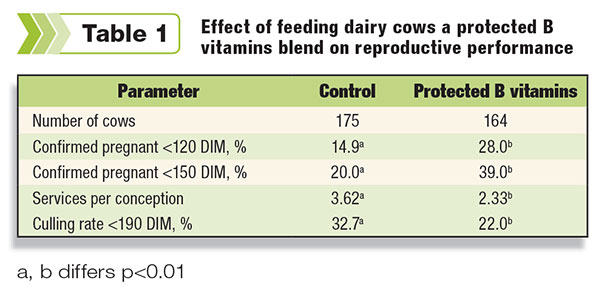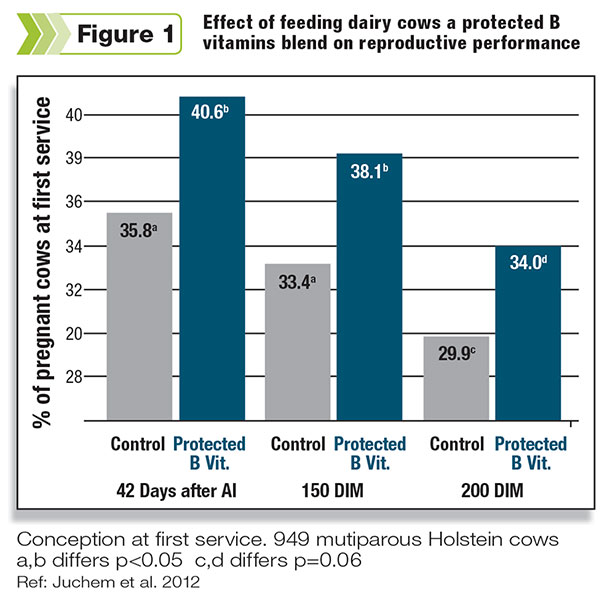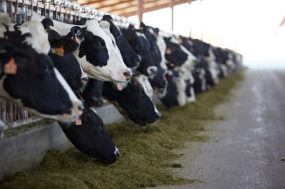Reproduction problems represent 18 percent of the culling rate and are stated to be the main reasons for involuntary culling in dairy herds.
This has a high economical impact for the dairy producer since this will represent less revenue on milk and calves and increased expenses on A.I., veterinary costs and replacement heifers.
Pregnancy rate is the best indication of herd reproductive performance and is calculated as the number of cows confirmed pregnant divided by the number of cows eligible for breeding. Increasing the pregnancy rate by one percentage unit will represent a savings of almost $17 per cow when pregnancy rate is low.
For a 100-cow herd, an improvement of pregnancy rate from 13 to 17 percent will increase the revenue by approximately $6,800 per year.
Management factors like cow comfort, heat detection, etc., are involved in reproductive performance and many articles have been written on these subjects. I will focus on some other important issues.
First, let’s look at energy balance. Energy balance is negative when the energy intake from the diet is not sufficient to supply the needs of the cow for milk production.
The lack of energy is supplied by the mobilisation of fat and muscle tissues so the dairy cow loses body condition score and become in negative energy balance. This process is common during the early lactation period; however, when it becomes excessive, it creates health and reproduction problems.
In general, each 0.5 units (scale of five) loss of body condition score will show a decrease of 10 percent of conception rate. This is mostly due to hormonal changes that will delay ovulation and reduce the percentage of cows getting pregnant early.
Only 45 percent of cows are pregnant at 150 days in milk (DIM) when their first ovulation is later than 50 DIM, compared to 75 percent when they ovulate earlier.
Dairy cows in negative energy balance will also have higher blood levels of non-esterified fatty acids (NEFA) and beta-hydroxy butyrate (BHB). Those metabolites will negatively impact the immune system of the cow by reducing the concentration of the immune cells and their function.
A reduced immune function during the transition period will increase the risk of reproductive diseases like retained placenta, metritis and endometritis.
Any means to avoid the drop of dry matter intake during the transition period, especially before calving, and to improve the energetic efficiency of the cow will alleviate negative energy balance.
The nutrient composition of the ration is one of them, including the supplementation of protected B vitamins. Some B vitamins play specific roles in the energy metabolism of the cow, are involved in the immune function and the follicular development – this will improve reproductive performance. Since they are rapidly degraded in the rumen, B vitamins need to be protected when supplemented in the diet.
Dairy cows fed a protected blend of B vitamins (folic acid, riboflavin and choline) during the transition period showed better health and reproductive performance than non-supplemented cows.
Blood BHB levels were lower, which is an indicator of an improved energy balance; mastitis and metritis incidence rate was reduced and more cows were pregnant early.
A recent commercial trial on a large dairy farm in California confirmed the reproduction benefit of feeding the same protected blend of B vitamins during the transition period.

When compared to the same period of the previous year, more cows were pregnant earlier and services per conception were reduced in the protected B vitamins supplemented group. Moreover, the culling rate was reduced by 33 percent, and this results into a significant economic impact for the producer (Table 1).
A research study with multiparous cows supplemented with a specific blend of protected B vitamins for the lactation period (folic acid, pyridoxine, pantothenic acid, biotin and B12) showed improved reproductive performance.
No voluntary waiting period or synchronization program was used in this trial in order to evaluate the effect of the B vitamins on reproduction.

Days at first service and pregnancy loss were not different between groups, but first-service conception rate was improved by 13 percent in the supplemented group, with the same percentage of improvement until 200 DIM (Figure 1).
Since cumulative number of cows pregnant at 200 DIM was not different, it means cows got pregnant earlier with the supplementation of the protected B vitamins blend. Of economic importance, cows receiving the B vitamins had their culling rate reduced by 20 percent compared to the control group.
Dairy producers have a new opportunity to improve the reproductive performance of their dairy cows by supplementing rations with specific blends of protected B vitamins. Researchers have proven their benefits and will bring to the producer an innovative way to increase farm profit. PD
References omitted due to space but are available upon request. Click here to email an editor.

- Hélène Leclerc
- Technical Support and R&D
- Jefo Nutrition Inc.







